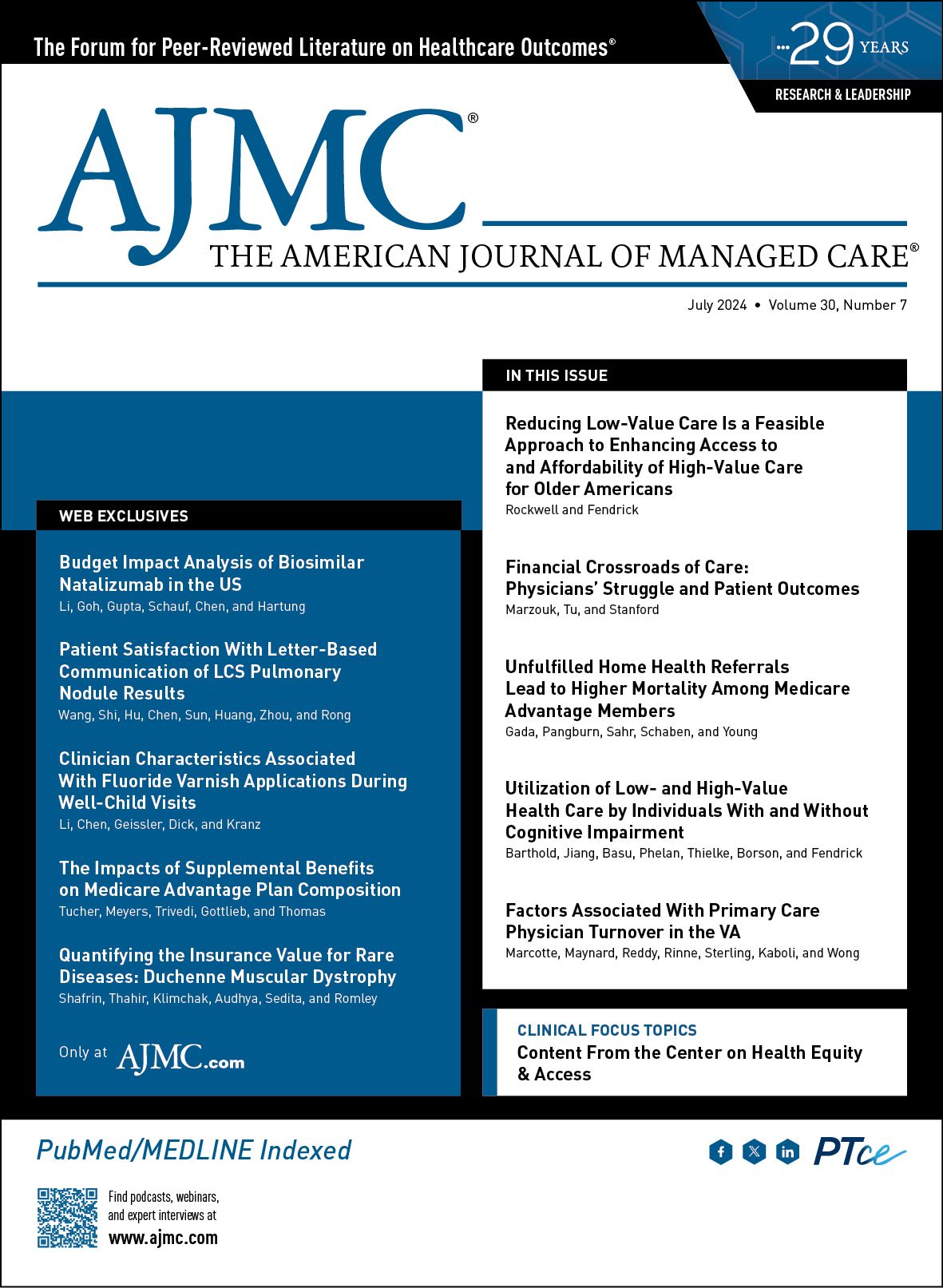Publication
Article
The American Journal of Managed Care
Financial Crossroads of Care: Physicians’ Struggle and Patient Outcomes
Author(s):
In 2024, physicians face significant financial challenges due to declining Medicare reimbursement rates and high student loan interest rates, which will impact health care delivery and access.
Am J Manag Care. 2024;30(7):305-307. https://doi.org/10.37765/ajmc.2024.89578
Takeaway Points
In 2024, physicians face significant financial challenges due to declining Medicare reimbursement rates and high student loan interest rates, which will impact health care delivery and access.
- Lower Medicare payments and high student loan debts are causing financial difficulties for doctors, potentially affecting their service quality and career choices.
- Reduced physician reimbursements and financial burdens may lead to health care shortages, especially in primary care and rural areas, affecting vulnerable populations.
- We underscore the urgency of policy interventions to address payment disparities and student debt to maintain a stable and effective health care system.
The financial landscape for physicians is undergoing a seismic transformation in 2024 as CMS implements sweeping changes to the Medicare Physician Fee Schedule (MPFS). This long-awaited recalibration aims to rectify historical imbalances and better align reimbursements with the value of services provided, particularly for cognitive evaluation and management (E&M) services. In 2021, CMS overhauled the fee schedule by increasing the work relative value units (RVUs) for most E&M codes by significant margins: approximately 15% for office/outpatient visits, 28% for inpatient/observation visits, and 26% for nursing facility visits.1 This unprecedented increase acknowledged a mounting body of evidence that E&M services were systematically and severely undervalued compared with procedural codes, with estimates of undervaluation ranging from 14% to 28%.2 By elevating the RVUs for these critical activities, such as diagnosis, treatment planning, risk assessment, and care coordination, CMS sought to compensate physicians more appropriately for their cognitive labor and nurture a health care system prioritizing thoughtful medical decision-making over procedural volume.
However, this projected $10 billion to $12 billion increase in E&M payments over 4 years was not intended as a permanent budgetary expansion beyond CMS’ jurisdictional authority.3 Instead, it represented the first phase of a multiyear process to fundamentally rebalance the fee schedule while remaining budget neutral overall, as mandated by Congress. To offset the rising costs from higher E&M valuations, CMS is now pursuing the next phase: adjusting the scaled conversion factor used to calculate payment rates for other services not receiving RVU increases. The proposed 3.4% conversion factor reduction in 2024 aims to eliminate the remaining financial deficit from the E&M increases while preserving their higher valuations. The impacts of this rebalancing are, however, uneven across certain medical specialties. Projections estimate that primary care specialties, such as family medicine, could see an almost 2% increase in allowed Medicare payments.4
Conversely, some fields face reduced Medicare reimbursements overall, including radiology (–3% projected), emergency medicine (–1%), anesthesiology (–8%), and interventional radiology (–9%).5 This divergence stems from the reality that cognitive specialists like primary care physicians derive a much larger portion of their revenues from E&M billings compared with proceduralists. As E&M payments rise, the former group benefits disproportionately before factoring in the conversion factor reduction. This rebalancing reflects long-simmering debates around the methodology used by the American Medical Association’s Relative Value Scale Update Committee (RUC) to recommend RVUs for physician work. Although the RUC aims to periodically adjust RVUs based on a comprehensive survey of physicians’ time, effort, and direct practice costs, critics argue its membership skews heavily toward procedural specialties and lacks representation from outside of medicine.6 Some analyses suggest the RUC has systematically and consistently undervalued E&M services relative to procedures by 10% to 18% on average over decades.7
This has progressively exacerbated compensation disparities between cognitive and procedural care despite Primary Care Incentive Payment Program increases by Congress. The RUC has also faced scrutiny over the opacity of its processes and the credibility of specialty survey data used to calculate recommended RVUs, which CMS has historically accepted more than 90% of the time.8 Alongside these changes in payment policies, another disruptive force is impacting physician finances: soaring interest rates on federal student loans. With the median debt burden for medical graduates reaching $200,000 in 2022, a significant portion of new physicians rely on federal loan programs offering lower, flexible interest rates and income-driven repayment plans to manage this substantial debt.9
However, due to surging Treasury yields amid rising inflation over recent years, the interest rates for new federal student loans have spiked from approximately 5.3% for 2021-2022 graduates to more than 7.2% for the 2023-2024 academic year.10 Consequently, physicians who graduated as recently as 2019 to 2021 often face interest rates 1 to 2 percentage points higher than their peers still in training or freshly entering residency programs. For a typical $200,000 debt load repaid over 10 years, this disparity equates to more than $24,000 in additional interest costs.11 The surge in borrowing rates compounds fiscal pressure for early career physicians already grappling with compressed earnings during residencies while deferring sizable loan balances. These intensifying pressures—the MPFS rebalancing and meteoric student debt interest hikes—are exacerbating broader systemic challenges facing the health care workforce, which had been steadily worsening in the years leading up to the COVID-19 pandemic.
More than one-third of US physicians report symptoms of burnout, with rates surpassing 50% in fields such as critical care, general surgery, and emergency medicine.12 Burnout risks have been tightly linked to workplace stressors, financial hardships, and excessive administrative/clerical burdens drawing clinicians away from patient care.13 Concerningly, approximately 27% of physicians indicated intentions to leave their current hospitals for a different workplace within 2 years if given the opportunity, signaling growing attrition risks that could severely strain care capacities without interventions.14 Despite stagnant growth in doctors per capita since 2010, the total physician workforce has continued expanding, reaching more than 1 million active professionals to keep pace with population gains.15 Medical school applications also topped 62,000 for the 2021-2022 cycle.16
Nevertheless, the compounded financial strains from reimbursement volatility and rising education costs risk severely impeding progress in fortifying the physician pipeline over time. Excessive fiscal duress could deter promising medical candidates from low-income backgrounds, perpetuate inequities in specialty and geographic workforce distribution, and exacerbate access gaps to primary and preventive care in already underserved rural and urban communities where 20% of Americans reside.17 To mitigate these mounting pressures, federal policy makers and health care stakeholders must pursue multifaceted solutions targeting both remediating financial disincentives and bolstering workforce resiliency. On the reimbursement front, some experts recommend Congress providing $3 billion to $5 billion annually in additional Medicare funding to offset the budget neutrality cuts stemming from higher E&M payments.18 Although it is deficit financed, this targeted investment could meaningfully reduce compensation disparities emerging from the MPFS rebasing.
Alternatively, CMS could collaborate with medical societies to fundamentally revise the RUC methodology itself, instituting more transparent and inclusive processes to accurately capture clinical practice costs and overhead across all specialties. A complementary solution involves doubling down on value-based payment reforms already underway to accelerate the transition away from fee-for-service and RVU-based billing models. For example, initiatives like the Medicare Shared Savings Program for accountable care organizations have steadily expanded to cover more than 11 million beneficiaries and generate $1.2 billion in net savings to Medicare as of 2020.19
Expanding adoption of such alternative payment models focused on quality, outcomes, and care coordination could help realign incentives beyond procedural volume while diminishing specialty payment divergences stemming from the MPFS rebalancing. From the medical education perspective, relief programs like income-driven repayment plans and the Public Service Loan Forgiveness program show promise in easing debt burdens and influencing specialty choices toward primary care. As of 2022, more than $1.74 billion in loans had been discharged for thousands of physicians and medical professionals under these programs.20 Analyses indicate that physicians participating in loan forgiveness were almost 30% more likely to pursue generalist fields such as family and internal medicine vs nonparticipants, although debt’s impact may be concentrated in the highest indebtedness quartile (debt greater than $300,000).21
Sustaining these efforts while expanding scholarship and service-tied funding opportunities could nurture a more economically diverse physician workforce. Moving forward, balancing respect for clinicians’ rightful concerns about fair compensation with reality-grounded solutions will require open communication and difficult trade-offs. Simply portraying MPFS changes as “cuts” or looming bankruptcy overlooks their role in repairing a financially strained system. Framing interest rate dynamics as existential threats minimizes programs to facilitate debt management.
Yet equally, the health care system cannot afford to ignore these fiscal pressures indefinitely without risking exacerbated workforce shortages, declining professional satisfaction, and compromised quality and access to care, especially for disadvantaged patient populations. A path forward necessitates acknowledging the defensible premise behind rebalancing fee schedules while instituting safeguards against unintended specialty disparities. It means strategically expanding education financing options to empower promising medical candidates regardless of socioeconomic background.
It also demands substantive cross-stakeholder collaboration—among policy makers, providers, payers, and educators—to reinforce the resilience and sustainability of the US health care system over the long term. Although the road ahead involves complex trade-offs, remaining committed to evidence-based solutions can chart an equitable course, one that compensates the value of cognitive care appropriately, empowers diverse talent to join medicine affordably, incentivizes quality over volume, and ultimately elevates the preeminent priority: ensuring accessible, high-caliber care for all patients.
Author Affiliations: Department of Medicine, Northwestern University Feinberg School of Medicine (SM), Chicago, IL; Department of Sociology, Department of the History of Science, Harvard College (LT), Cambridge, MA; Massachusetts General Hospital (MGH), MGH Weight Center, and Department of Medicine–Division of Endocrinology-Neuroendocrine, Department of Pediatrics–Division of Endocrinology, and Nutrition Obesity Research Center at Harvard (FCS), Boston, MA.
Source of Funding: National Institutes of Health NIDDK U24 DK132733, UE5 DK137285 (FCS), and P30 DK040561 (FCS).
Author Disclosures: The authors report no relationship or financial interest with any entity that would pose a conflict of interest with the subject matter of this article.
Authorship Information: Concept and design (SM, LT, FCS); acquisition of data (SM); analysis and interpretation of data (SM); drafting of the manuscript (LT, FCS); critical revision of the manuscript for important intellectual content (LT, FCS); and supervision (FCS).
Address Correspondence to: Fatima Cody Stanford, MD, MPH, MPA, MBA, MGH Weight Center, 50 Staniford St, 4th Floor, Boston, MA 02114. Email: fstanford@mgh.harvard.edu.
REFERENCES
1. Calendar year (CY) 2024 Medicare Physician Fee Schedule proposed rule. CMS. July 13, 2023. Accessed July 23, 2023. https://www.cms.gov/newsroom/fact-sheets/calendar-year-cy-2024-medicare-physician-fee-schedule-proposed-rule
2. Final policy, payment, and quality provisions changes to the Medicare Physician Fee Schedule for calendar year 2021. CMS. December 1, 2020. Accessed July 23, 2023. https://www.cms.gov/newsroom/fact-sheets/final-policy-payment-and-quality-provisions-changes-medicare-physician-fee-schedule-calendar-year-1
3. Dillion JT, Minton JW. Medicare reimbursement: how the AMA Relative Value Update Committee (RUC) works and who is involved. American Academy of Otolaryngology–Head and Neck Surgery. October 21, 2013. Accessed July 17, 2023. https://bulletin.entnet.org/home/article/21245434/medicare-reimbursement-how-the-ama-relative-value-update-committee-ruc-works-and-who-is-involved
4. 2024 MPFS: AAFP presses for greater primary care investment. American Academy of Family Physicians. September 21, 2023. Accessed June 5, 2024. https://www.aafp.org/news/government-medicine/2024-mpfs-comments.html
5. Final Medicare 2024 rule would cut physician payments by 3.4%. California Medical Association. November 7, 2023. Accessed January 14, 2024. https://www.cmadocs.org/newsroom/news/view/ArticleId/50344/Final-Medicare-2024-rule-would-cut-physician-payments-by-3-4
6. Edsall RL. The RUC under fire. Fam Pract Manag. 2011;18(5):10.
7. Equalizing Medicare payments regardless of site-of-care. Committee for a Responsible Federal Budget. February 23, 2021. Accessed January 14, 2024. https://www.crfb.org/papers/equalizing-medicare-payments-regardless-site-care
8. Williams RD. What is the RUC—and why do we care? American Academy of Ophthalmology. February 1, 2022. Accessed June 5, 2024. https://www.aao.org/eyenet/article/what-is-the-ruc-and-why-do-we-care
9. American Association of Medical Colleges. Medical student education: debt, costs, and loan repayment fact card for the class of 2022. West Michigan University Homer Stryker M.D. School of Medicine. October 2022. Accessed June 6, 2024. https://wmed.edu/sites/default/files/aamc-debt-fact-card-2022.pdf
10. (DL-22-04) Interest rates for direct loans first disbursed between July 1, 2022 and June 30, 2023. Federal Student Aid. May 24, 2022. Updated June 27, 2022. Accessed July 23, 2023. https://fsapartners.ed.gov/knowledge-center/library/electronic-announcements/2022-05-24/interest-rates-direct-loans-first-disbursed-between-july-1-2022-and-june-30-2023
11. 2023 facts: applicants and matriculants data. Association of American Medical Colleges. Accessed July 21, 2023. https://www.aamc.org/data-reports/students-residents/data/2023-facts-applicants-and-matriculants-data
12. Sinsky CA, Trockel MT, Dyrbye LN, et al. Vacation days taken, work during vacation, and burnout among US physicians. JAMA Netw Open. 2024;7(1):e2351635. doi:10.1001/jamanetworkopen.2023.51635
13. Pisaniello MS, Asahina AT, Bacchi S, et al. Effect of medical student debt on mental health, academic performance and specialty choice: a systematic review. BMJ Open. 2019;9(7):e029980. doi:10.1136/bmjopen-2019-029980
14. Ligibel JA, Goularte N, Berliner JI, et al. Well-being parameters and intention to leave current institution among academic physicians. JAMA Netw Open. 2023;6(12):e2347894. doi:10.1001/jamanetworkopen.2023.47894
15. Cheney C. New census: more than 1M physicians practicing medicine in United States. HealthLeaders. July 21, 2023. Accessed January 14, 2024. https://www.healthleadersmedia.com/clinical-care/new-census-more-1m-physicians-practicing-medicine-united-states
16. Boyle P. Medical school applicants and enrollments hit record highs; underrepresented minorities lead the surge. American Association of Medical Colleges. December 8, 2021. Accessed March 21, 2024. https://www.aamc.org/news/medical-school-applicants-and-enrollments-hit-record-highs-underrepresented-minorities-lead-surge
17. Smith TM. Why student-loan forgiveness is making primary care more attractive. American Medical Association. June 9, 2019. Accessed January 25, 2024. https://www.ama-assn.org/medical-students/specialty-profiles/why-student-loan-forgiveness-making-primary-care-more
18. Fact sheet: Medicare site-neutral legislative proposals would jeopardize access to care. American Hospital Association. May 2023. Accessed January 21, 2024. https://www.aha.org/fact-sheets/2023-05-22-fact-sheet-medicare-site-neutral-legislative-proposals-would-jeopardize-access-care
19. CMS: Medicare ACOs save $1.9B in 2020. American Hospital Association. August 25, 2021. Accessed January 21, 2024. https://www.aha.org/news/headline/2021-08-25-cms-medicare-acos-save-19b-2020
20. The Public Service Loan Forgiveness Program (PSLF). American College of Physicians. Updated February 14, 2022. Accessed March 17, 2024. https://www.acponline.org/advocacy/state-health-policy/the-public-service-loan-forgiveness-program-pslf
21. Scheckel CJ, Richards J, Newman JR, et al. Role of debt and loan forgiveness/repayment programs in osteopathic medical graduates’ plans to enter primary care. J Am Osteopath Assoc. 2019;119(4):227-235. doi:10.7556/jaoa.2019.038

Newsletter
Stay ahead of policy, cost, and value—subscribe to AJMC for expert insights at the intersection of clinical care and health economics.






